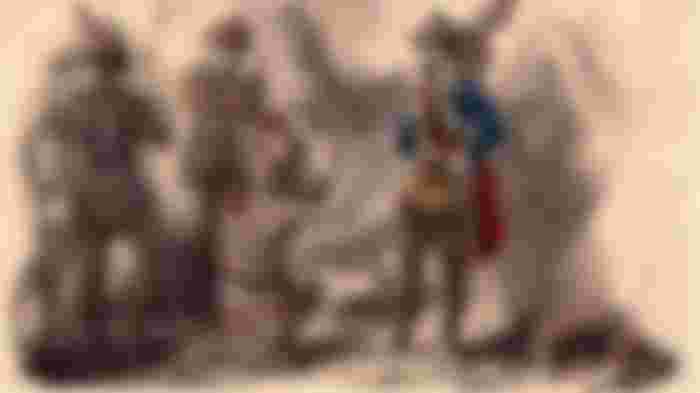ALLIES RELEASE ULTIMATUM FOR JAPAN'S SURRENDER TO WAR
July 26, 1945

In the last months of World War II, the country of Japan became the remaining threat to the pursuit of the Allies forces in achieving world peace. And the Japanese, despite imminent defeat and collapse, were determined to fight to the death. So on this day in 1945, a declaration was drafted by the leaders of the three Allies forces President Harry S. Truman of the United States, Premier Joseph Stalin of the Soviet Union, and Prime Minister Winston Churchill of the United Kingdom, in conjunction with their conference in Potsdam, Germany. It was an ultimatum to force Japan to surrender unconditionally to the war as soon as possible, otherwise, it would face massive land, naval, and air aggression by American forces until Japan was allowed to surrender.
The ultimatum also called for the complete surrender and disarmament of the Japanese Imperial army, the prosecution of its war criminals, and the establishment of a more democratic Japanese government. If Japan complies with and accepts these provisions, the Allied forces will respect the power of the Emperor of Japan, and allow its industries to operate without regard to the manufacture of weapons of war, and resume trade between Japan and the United States. global market.
Coinciding with President Truman’s arrival in Germany on July 16, he received news of the success of testing the atomic bomb, which he was confident would save more Americans from their planned invasion of Japan. He informed Stalin, but what President Truman did not know was that Stalin already knew it because he had spied on the Manhattan Project.
Truman, Churchill, and Stalin began a conference on 17 July in Potsdam, Germany to discuss the future of Europe after the war, including dividing Germany into four zones and prosecuting it. of war criminals. The Potsdam conference ended with the signing of the Potsdam Agreement in August 1945.
The Allies' demands for their surrender reached Japan, but the Japanese government led by Prime Minister Kantaro Suzuki declared their non -response to the Potsdam Declaration, using the word tokusatsu or meaning silent kill. This decision will determine Japan's tragic fate next month.
PHILIPPINES SIGN UNITED NATIONS CONVENTION ON THE RIGHTS OF THE CHILD
July 26, 1990

The United Nations Convention on the Rights of the Child (UNCRC) aims to further strengthen the 1959 UN Declaration on the Rights of the Child. And on July 26, 1990, the Philippines became the 31st country to sign such an international agreement.
On November 20, 1989, the UN General Assembly adopted the UNCRC under Resolution 44/25. In addition to tightening the provisions of the 1959 declaration, it is emphasized here that children are people and individuals who also have the right to be respected and protected. The document also states that childhood begins from birth to before reaching the age of 18 and that a child should be allowed to play, learn, enrich talents and abilities, and grow as an individual with dignity in these times. To accomplish this, the government of each country must create policies that protect children from abuse, discrimination, violence, and exploitation. The government also needs to put in place programs that address the health needs of children, and allow them to participate in society.
The Philippines, through our representative Deputy Permanent Representative to the UN Manuel Mendez, signed the said document on July 26, 1990. Although the said agreement took effect globally and began to be implemented on September 2, 1990, it came into force. only the document in the Philippines on September 20, 1990, 30 days after the country provided the instrument of ratification to the UN Secretariat.
According to the last count in 2020, 196 countries in the world have signed the UNCRC.
FRANCISCO PIZZARO EXECUTES THE LAST LEADER OF THE INCA EMPIRE, ATAHUALPA
July 26, 1533

On this day in 1533,the last Emperor of the ancient Inca Empire Atahualpa was executed.
After Spanish forces captured Emperor Atahualpa of the Inca Empire in November 1532, Pizarro imprisoned him and released him only on the condition that Atahualpa grants his request for a large room full of Inca gold treasures that would reach more than two meters. the height, in the aggregate gold treasures of the Incas. The said room was also doubly filled with silver treasures. Eight months were spent on this work demanded by Pizarro, which at the current cost they would amount to 50 million dollars. Atahualpa was allowed to rule even as a prisoner of Pizarro to continue the collection of Inca treasures. But when Pizarro's demand for wealth was completed he did not keep his promise to free Atahualpa, and instead he was indicted in a Spanish court on charges of rebellion against the Spaniards, idolatry, and murder of his half-brother. and Huascar. He was sentenced to death by burning, and the morning before he was killed he was first baptized into the Catholic religion and hanged by strangulation, as he had requested. He was given a Christian burial afterward.
Atahualpa only briefly served as Emperor of the Inca, and his empire faced the problem left behind by a bloody civil war of six years against his half-brother Huascar. Add to this the intensification of the smallpox epidemic throughout the empire brought on by the Spanish occupiers under the leadership of Francisco Pizarro, who had already killed nearly 90 percent of the empire's population. Atahualpa captured the throne after his father Wayna Qhapac died of smallpox, from the civil war that the Spaniards took advantage of to finally conquer the Incas. However, the Incas lived in luxury under the leadership of Atahualpa, who was also wanted by the Spaniards. Atahualpa tried to resist the attempts of foreigners to conquer their empire, but also fell into the hands of Pizarro.
Atahualpa's death signaled the end of nearly three centuries of the largest empire in southern America.
References:
History.com Editors (2021, May 18). Potsdam Conference. History.com. https://www.history.com/.amp/topics/world-war-ii/potsdam-conference
Project Vinta (2020, July 26). On July 26, 1990, the Philippines became the 31st country to ratify the United Nations Convention on the Rights of the Child (UNCRC). [Status update]. Facebook. https://m.facebook.com/story.php?story_fbid=2727018057545450&id=1922575111323086
United Nations Children’s Fund (n.d.). Frequently asked questions on the Convention of the Rights of the Child. Retrieved July 26, 2021. https://www.unicef.org/child-rights-convention/frequently-asked-questions
Cartwright M. (2016, March 17). Atahualpa. World History Encyclopedia. https://www.worldhistory.org/Atahualpa/



This takes me back to my school days when we were learning about history :D